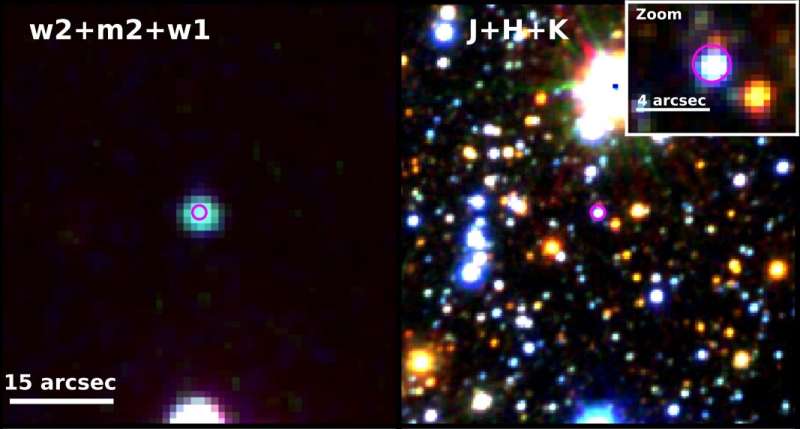June 20, 2023 report
This article has been reviewed according to Science X's editorial process and policies. Editors have highlighted the following attributes while ensuring the content's credibility:
fact-checked
preprint
trusted source
proofread
Binary star system 1RXS J165424.6-433758 revealed to be polar, new observations find

An international team of astronomers has performed X-ray, ultraviolet, and optical observations of an X-ray source known as 1RXS J165424.6-433758. Results of the observational campaign, published June 8 on the pre-print server arXiv, shed more light on the nature of this source, providing evidence that it is a polar.
Binary System 1RXS J165424.6-433758 revealed to be polar, new observations find
Cataclysmic variables (CVs) are binary star systems comprising a white dwarf and a normal star companion. They irregularly increase in brightness by a large factor, then drop back down to a quiescent state. Polars are a subclass of cataclysmic variables distinguished from other CVs by the presence of a very strong magnetic field in their white dwarfs.
1RXS J165424.6-433758 (or AX J165420-4337) was first identified as an X-ray source by the ROSAT satellite more than three decades ago. However, although the source is known to astronomers for such a long time, its true nature remains a mystery.
Now, a new study published by a group of astronomers led by Brendan O'Connor of the George Washington University in Washington, DC, claims that the nature of 1RXS J165424.6-433758 has been finally determined, thanks to multiwavelength observations using various spacecraft and ground-based facilities.
"Here, we present DGPS [Deep Galactic Plane Survey] observations and follow-up of the source with Swift, NuSTAR, the Southern African Large Telescope, and the South African Astronomical Observatory 1-m telescope, as well as archival XMM-Newton observations. Our data show that 1RXS J165424.6-43375 (hereafter J1654) is a typical polar mCV [magnetic cataclysmic variable] at a distance of ∼ 460 pc," the researchers wrote in the paper.
The observations found that J1654 showcases a hard X-ray spectrum in the high-state characterized by thermal bremsstrahlung radiation with temperature of 10.1 keV and luminosity at a level of about 65 nonillion erg/s. Further investigation led to the finding that J1654 is a magnetic CV with an orbital period of 2.87 hours and a magnetic field of 3.5 MG.
The astronomers noted that J1654 lies within the so-called CV period gap (between two and three hours). This is a common property of the population of known polar mCVs, which do not exhibit a prominent period gap. Moreover, the overall X-ray, ultraviolet, optical, and infrared properties of J1654 also confirm the polar scenario for this system.
The results suggest that the donor star in the J1654 system is a main-sequence star of a late spectra type, with a radius of about 0.38 solar radii and an effective temperature of 4,300 K. The white dwarf is estimated to have a mass of some 0.58 solar masses.
The accretion rate for J1654 was calculated to be about 10-11 solar masses per year. According to the authors of the paper, this result is comparable to the expected values for systems whose evolution is driven purely by gravitational wave radiation.
More information: O'Connor et al, Identification of 1RXS J165424.6-433758 as a polar cataclysmic variable, arXiv (2023). DOI: 10.48550/arxiv.2306.05576
Journal information: arXiv
© 2023 Science X Network





















